Family holds vigil for UPD shooting victim
By Dominique Huber STAFF WRITER
A small group of family and friends gathered Tuesday evening for the vigil of Antonio Guzman Lopez, who was killed by San Jose State University Police Department officers nine years ago.
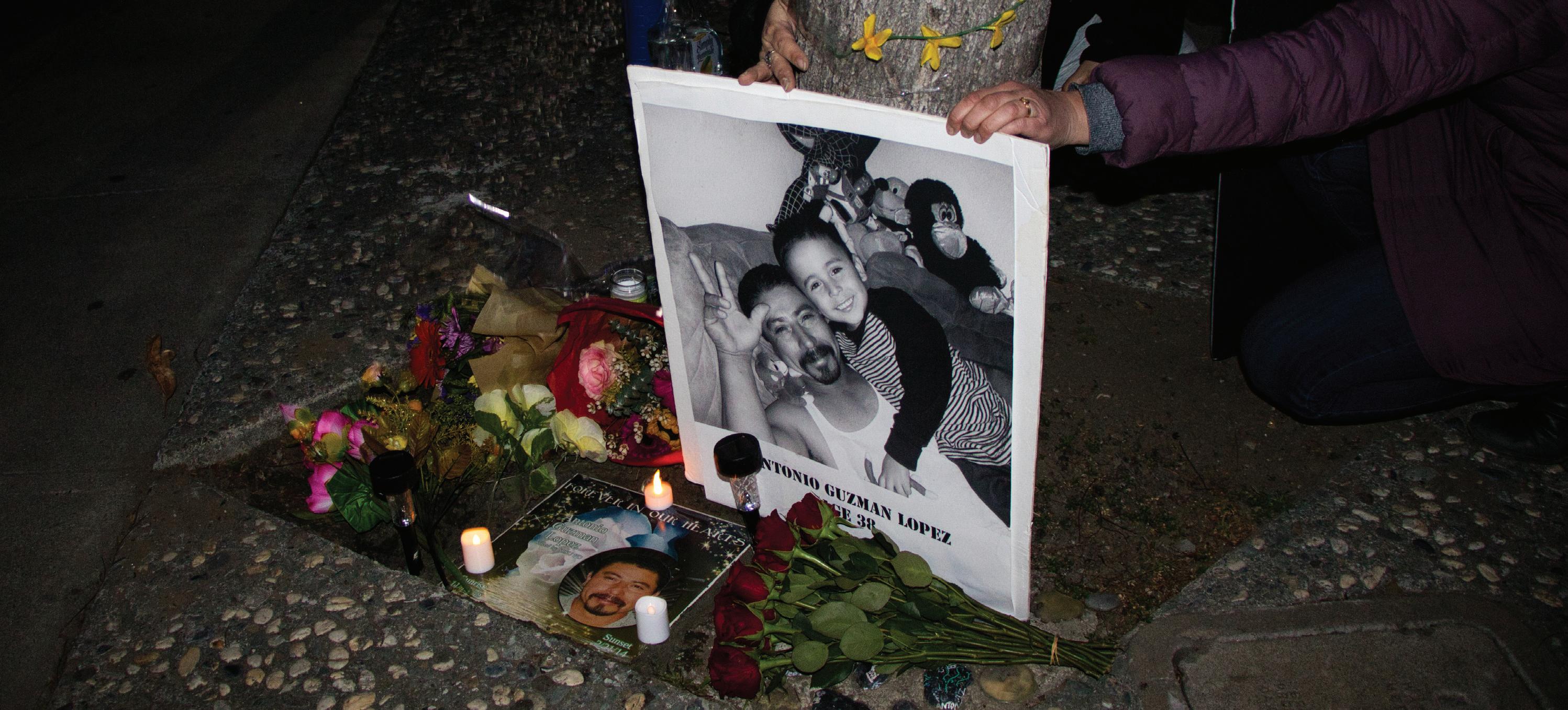
Lopez was shot during a confrontation with two UPD officers on Feb. 21, 2014.
According to the UPD police report, officers were called after there were reports of a man wielding a knife on the intersection of S. Eighth and San Salvador St.
When officers arrived at the scene, they thought Lopez was acting strange because of alcohol or drugs, according to the UPD police report.
When officers told Lopez to drop the weapon, he refused and started to run away, according to the same report.
Lopez was then shot twice in the back. One of the bullets went through his body and into a nearby sorority house, according to a 2019 NBC Bay Area article.
Laurie Valdez, who was Lopez’s partner for seven years at the moment of his death, was one of the key speakers at the vigil.
“Something wrong was done here,” Valdez
She said the hardest part about losing Lopez was explaining to her son why his dad died that night.
“We try to keep putting up the memorial every year right here,” Valdez said. “Antonio was buried in Nayarit, Mexico so my son, the only place he has to remember his dad is right here where they took his life. He’s been growing up without his dad and he wants accountability.”
Social work masters student Lana Gomez, is one of Valdez’s friends who participate in the vigil.
Gomez said UPD needs to do more than just show up to vigils and say they support police reform.
He was transported to a nearby hospital where he died from his wounds, according to the same NBC article.
said. “All the students that come through will know the story and they won’t brush it under the rug.”
“The best thing the San Jose community can do to support victims of police brutality is to really hear the voice of those who have
VIGIL | Page 2
Disaster response team talks safety
By Enrique Gutierrez-Sevilla STAFF WRITER
San Jose State, located around the Calaveras, San Andreas and Hayward-Rodgers Creek faults, is vulnerable to earthquakes.
SJSU’s emergency response and preparedness program works to create and enforce emergency operation plans in response to natural disasters.
The 7.8 magnitude earthquake in Türkiye and Syria has drawn concerns from students about the safety of SJSU campus if it were to experience an earthquake of similar magnitude.
Some campus buildings including Tower Hall, Morris Dailey Auditorium, Dwight Bentel Hall and Yoshihiro Uchida Hall were built over 100 years ago, some of which were a part of the 1906 San Francisco earthquake according to SJSU King Library Digital Collections.
Traci Ferdolage, senior associate vice president of Facilities, Development and Operations, said campus buildings were built under the California Building Code and California State University Seismic Policy.
“The CSU system is focused on safety for students, faculty and staff for any type of emergency,” Ferdolage said.
Seismic policy requirements were implemented by the Board of Trustees, according to the CSU Office Of The Chancellor.
The board of trustees is a 25-member committee that governs the entire CSU system through campus planning, education policy, facilities, and finances.

CSUs perform independent technical peer reviews to inspect construction and design of campus buildings to ensure that protective safety measures are in place to avoid severity of injury from an earthquake, according to the CSU seismic policy.

“Campus buildings were evaluated for seismic safety over the last few years and all were determined to be suitable for ongoing use,” Ferdolage said.
EARTHQUAKE | Page 2
SERVING SAN JOSE STATE UNIVERSITY SINCE 1934 WWW.SJSUNEWS.COM/SPARTAN_DAILY Volume 160 No. 12 Wednesday, Feb. 22, 2023 NAMED NATIONAL FOUR-YEAR DAILY NEWSPAPER OF THE YEAR FOR 2020-21 IN THE COLLEGE MEDIA ASSOCIATION’S PINNACLE AWARDS
ENRIQUE GUTIERREZ-SEVILLA | SPARTAN DAILY
Huda Mirza, justice studies junior and Mehmood Rahmatullah, applied and computational math senior, present baked goods at the Türkiye and Syria earthquake relief bake sale on Tuesday afternoon at the MOSIAC Cross Cultural Center.
BRYANNA BARTLETT | SPARTAN DAILY
Two vigil attendees hold up a poster that features Antonio Guzman Lopez and his son, Josiah, at South Eighth and East San Salvador streets – the location of his death in 2014.
They need to do real work and honestly put their money where their mouth is. You’ve caused so much pain– pay these families, create scholarships in their name, talk to them and see what they want directly.
Lana Gomez social work masters student
EARTHQUAKE
Continued from page 1
SJSU Facilities Department and Operations stands with the CSU seismic policy, prepared to support the campus as needed to respond to a natural disaster.
When an earthquake occurs near a CSU campus or facility, there is immediate need for evaluation of the safety of buildings and facilities at campus, according to the CSU seismic policy.
Facilities Department and Operations and the University Police Department have made plans to work together during an incident of this nature.
“[Facilities Department and Operations] would first focus on safety and evacuations as well as ensuring there are no other utility issues which could further compound the challenges from a seismic event, in example, natural gas, line ruptures, electrical lines down, etc,” Ferdolage said.
She also said Facilities Department and Operations would work with UPD and other campuses to methodically ensure buildings were evacuated, and then begin to assess damages to determine if a building is
VIGIL
Continued from page 1
been affected,” she said.
“ ‘Lets paint this mural and then take a pic with the fam and slap it all over social media,’ like no that’s not what it’s about,” Gomez said. “They need to do real work and honestly put their money where their mouth is. You’ve caused so much pain– – pay these families, create scholarships in their name, talk to them and see what they want directly.”
inhabitable or must be closed.
Ferdolage said the initial focus would be on life safety before turning to property damage control and safety.
“The Chancellor’s Office has an emergency management policy that says each campus needs to have an emergency preparedness manager like myself, as well as an emergency operation center,” said emergency services manager Mike Edwards.
The Emergency Operations Center serves as an emergency team that communicates with UPD to find out what is happening and if any resources are needed.
University Police Department Capt. Frank Belcastro said UPD would conduct a windshield survey to assess damage and provide assistance to injured persons.
A windshield survey is when UPD will drive around to collect data post-earthquake and note conditions of the community.
After the survey, engineers and seismologist professionals from the CSU system will check buildings.
In the immediate event of an earthquake, emergency services, EOC, UPD and the president plan to attend to such matters.
“With consultation through Traci and her team, if buildings were not safe to be occupied,
Among those in attendance was Raj Jayadev, co-founder of Silicon Valley De-Bug and Valdez’s friend.
Silicon Valley De-Bug is a community organizing, advocacy and multimedia storytelling organization, according to the Silicon Valley De-Bug website.
Jayadev said UPD is not needed and should not exist on campus.
“It only invites violence, and it makes the students unsafe,” Jayadev said. “As we recognized here today, it makes the residence of this university community unsafe.”
He also said the presence of a
we would then through the police department and through working with the president’s office, order an evacuation of campus and you’ll get the SJSU alert that comes to your phone through texts,” Edwards said.
If there is no signal or service, Edwards said SJSU plans to communicate through public address systems on campus, blue light phones and will have police cars going around with loudspeakers alerting people.
SJSU has emergency supplies spread across campus in big old shipping containers, two on the main campus and one on South Campus.
“We’ve got three of those filled with emergency supplies on campus, from everything from triage, medical, gurneys and tents,” Edwards said.
Edwards said he believes the university systems could do a better job communicating resources and information to students and faculty.
“My goal is someday in the future for there to be emergency preparedness information in course syllabi,” Edwards said. “All campuses should have the basic evacuation, earthquake, fire, active run, duck, and hide in every single syllabi so professors could have those conversations with students that first day of class of course syllabus introduction.”
mental health professional could have prevented Lopez’s death.
“The people that called 911 nine years ago needed to be able to call a line that helped people that potentially may be going through a mental health episode,” Jayadev said. “They weren’t armed and weren’t going to kill the person or incarcerate them.”
Other community members who experienced family members who died because of police brutality also came to participate in the vigil. Corina Cardenas is one of those people.
Edwards said he encourages people to prepare themselves for any type of huge disaster because there is a finite amount of people that can come around during an emergency.
The SJSU Muslim Student Association held an earthquake relief bake sale to provide relief for Türkiye and Syria’s earthquake on Tuesday.
The association had basbousa, spinach borek, biscoff cake, cookies, cupcakes and popcorn for sale at the fundraiser.
Mehmood Rahmatullah, applied and computational math senior, is one of the organizers for the association and was present for Tuesday’s event.
“Türkiye and Syria are predominantly Muslim countries and when anything happens overseas, it’s our responsibility to do anything in our power to help out the victims of said disasters,” Rahmatullah said.
All funds raised will be given to the Zakat Foundation of America. The foundation is a Muslim-run charity that does humanitarian actions aiding those in need around the world.
“This is a start, based on whatever capacity our club has, we function within that,” Rahmatullah said.
Her dad, Rodolfo Cardenas, was shot and killed by a State Bureau of Narcotic Enforcement agent in San Jose downtown in Feb. 2004, according to a Sept. 28, 2006 SFGate article.
“As far as police following protocols, they’re not gonna follow them if they’re not being held accountable,” said Cardenas.
According to the City of San Jose website, all officer-involved shootings are investigated and an internal investigation by the SJPD Internal Affairs investigates the officer’s conduct during the shooting.
Valdez concluded the vigil by thanking the San Jose community for supporting the family and standing against police brutality.
“We have to remember him and not let the world forget that a wrong was done here,” Valdez said. “An injustice was done here.”
Marine biologist discusses research work
By Mat Bejarano STAFF WRITER
While most professors are limited to lecture halls and classrooms, Amanda Kahn, assistant professor at Moss Landing Marine Laboratories, uses the sea.

Kahn focuses her work on sponges and invertebrates.
The Moss Landing Marine Lab has several laboratories that are shared among the seven California State Schools in Moss Landing, California, according to the MLML website.
“They say if you want to think of how we explore the deep sea, it would be like walking around in New York City with only a flashlight and you can only see New York with what your flashlight illuminates,” Kahn said.
Kahn’s research focused on the “sponge loop” and how sponges are able to turn bacteria into food that other animals can eat.
“Sponges sit in a really unique position in the food web that they live in because they’re able to tap into this food source that other animals can’t,” Kahn said. “That sort of transformation can make sponge areas where there are lots of sponges, almost like oases of food in those food poor habitats.”
poor habitats
She said a way to prevent harm to invertebrates is by understanding the impact humans have on them.
“Deep-sea mining looks like it could be quite severe in its effects,” Kahn said . “T he material th at’s brought up and ground up for mining and then released is somethin g that can have a pretty rough effect on sponges.
She said deep-sea mining is scheduled to start this year and its rele vance and timeliness are important to sea species.
“We can have a really dr am at ic e ff ec t on ecosystems without even knowing what those effects are going to be,” Kahn said Sponges in soft sediment habitats depend on hard surfaces.
By removing those surfaces, organisms that occuppy y it and the larva that could grow annd inhaabi b t it may be removed, wrote Kahn in a Dec. 8, 2022 Vis i ible article
She initially began her research studies on deep-sea sponges in 2007, while she was pursuing her master’s degree in marine science at Moss Landing Marine Labs. She got more involved in sponges during her Ph.D. studies at the University
She initially began her in was pursuing her ma marine science at Moss L abs. She more invo her Ph.D. studies of Alberta in 2010.
with Kahn for the past three years. Their research looks at sponges in the past to predict how sponges will react to climate change.
“I came down to the Moss Landing Marine Labs open house when I was an undergraduate student and they had a display for their scientific diving program, and I breathed on a scuba regulator and was like, ‘Holy cow,’ ” Kahn said.
Kahn said her interest in sponges initially started after she went scuba diving
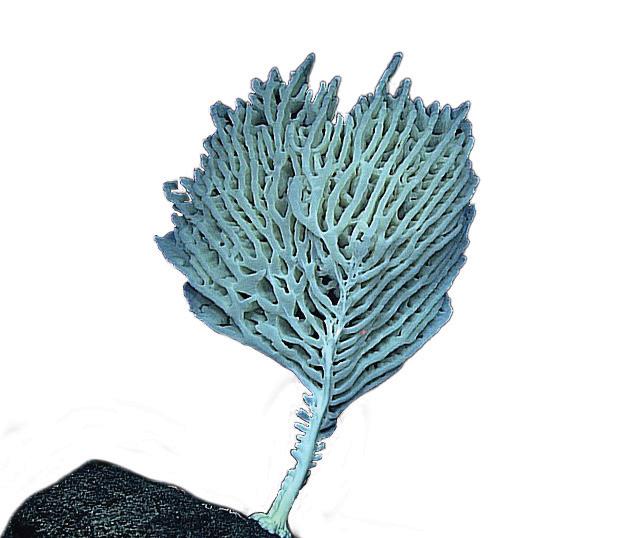
“I came down to th student for their scientific and I breathed on a scu was like, cow,’ ” Ka Kahn said her inte r initially started after she w during an internship.
“She’s incredibly enthusiastic,” Heller said. “She and I with this project are accomplishing more than we could possibly accomplish alone.”
Marine science master’s student Sydney McDermott is one of the students working in Kahn’s lab.
“[Kahn] always had something very relevant to bring so it’s not textbook learning,” McDermott said.
“I studied sponges and I realized in those 10 weeks that in the deep sea, we know very little about them, how they work, and I just kept on asking questions and finding that there was nothing in the literature to tell me answers,” Kahn said. “It’s sort of like a cool rabbit hole where
Assistant computer science professor Philip Heller is a collaborator of Kahn.
I an those 10 weeks that in t know ver y little about work, and I on and that there w literature to tell me answ sort a cool r you get stuck in it.” s collabor
Kahn incorporates her research as she teaches invertebrate zoology and marine ecology.
“Being able to talk about what I know from studying invertebrates is really great,” Kahn said. “I have research that’s coming out probably this year related to some work with octopuses and I’ve been bringing that up in my population biology class.”
He focuses his research on working with skeletal sponge samples.
He focuses his resea sam Heller said he has be
Heller said he has been collaborating
sjsunews.com/spartan_daily WEDNESDAY, FEB. 22, 2023 NEWS 2
PHOTO COURTESY OF AMANDA KAHN
SJSU assistant professor Amanda Kahn at Moss Landing Marine Laboratories holds a starfish during a research trip.
Farrea occa deep-sea sponges (pictured) are amoung the sponges Amanda Kahn researches. Follow The Spartan Daily on Twitter @spartandaily
Follow
The Spartan Daily on Twitter @spartandaily Follow The Spartan Daily on Twitter @spartandaily
Experts weigh in on transit inequities
By Christine Tran STAFF WRITER
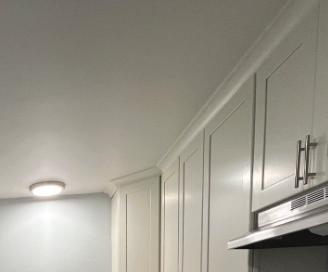

In the third of a four-part webinar series by the San Jose State’s Mineta Transportation Institute, keynote speakers Emma Huang and Joshua Schank shared their research on free transit.
The webinar focused on how lack of access to affordable mobility is connected to the lack of access to opportunities.
The speakers present fareless transit as a solution to improve equity for underserved communities.
Huang is a senior consultant at InfraStrategies LLC, a global advisory and management consulting firm focused on infrastructure project development, according to the Mineta Transportation Institute’s website.
Huang said her research highlighted three strategies that would help low-income people.
These strategies focused on charging no fares during non-peak hours, road pricing for drivers with personal vehicles and alternative transportation solutions.
“Low-income individuals can get funds to spend that is not limited to using on transit,” Huang said. “The idea here is to provide maximum flexibility and mobility options for those that need them the most.”
Schank, who is the Managing Principal at InfraStrategies LLC and a research associate at the Mineta Transportation Institute, addressed popular concerns against fareless transit such as the source of funding and long-term sustainability.
“Most U.S. transit agencies are actually kind of like Los Angeles Metro in the sense that a lot of their budget is not coming from fares and they are a small amount of their overall budget package,” Schank said.

He said another concern was




related to the houseless population using public transportation as temporary housing or shelter.






Schank questioned if the lowest income citizens should be charged to ride transit.
“There’s going to be homeless people on public transit as long as you have a homeless problem in your society,” Schank said. “To me, the marginal benefit of charging fares with respect to reducing homeless people on trains and buses does nothing to actually address the homeless problem.”
He said conflicts can arise over fare prices, sometimes leading to transit operators experiencing verbal or physical assault. Schank said fareless transit would
decrease the friction that often comes with fare enforcement.
“We did find [at the Los Angeles Metro] that over 50% of the assaults that were occurring to transit operators were fare related,” Schank said. “Operators are instructed, at Metro, not to enforce the fares beyond saying their fare is $1.75. There’s no other instruction beyond that but they often feel obligated to enforce the fare.”
He said transit operators’ safety can benefit from fareless transit pilot programs, which some communities have already instated.
“It’s faster for people to get on the bus. There’s a user and operational benefit where the operator [does not have] a potential continuous
conversation with someone to quote the fare,” Schank said. “Instead of trying to figure out multiple payment systems, it’s more efficient because the rider just gets on and doesn’t have to deal with that headache.”
Huang discussed the issue of funding that is common with fairless transit programs.
She said there are alternative ways to address the funding gap such as sales, tax adoption and property tax.
Schank urged politicians to advocate for free transit and plan to implement it in their communities.
“New York hasn’t quite gotten there but they got big hurdles to advocate on behalf of riders of the transit system and protest members of the assembly,” Schank said. “Often,

elected officials who profess to be in favor of improving equity promote policies that do exactly the opposite.”
Huang said the Area Transit Agency is an existing program that stands out to her as a program to emulate.
“[The Area Transit Agency] has a fabulous program right now and probably has had it for the longest [time]. I’m not sure if it’s been properly documented and whether they have a study of it, but that is something I would be excited to look at,” Huang said.
sjsunews.com/spartan_daily WEDNESDAY, FEB. 22, 2023 NEWS 3
GANBARUBY, CC BY-SA 4.0 VIA WIKIMEDIA COMMONS
Follow The Spartan Daily on Twitter @spartandaily
Fast fashion: clothing or garbage?
By Dominique Huber STAFF WRITER
Clothing can be a wonderful way to express oneself, but concerns over unethical practices in the fashion industry can make it hard to build a wardrobe with a clear conscience.
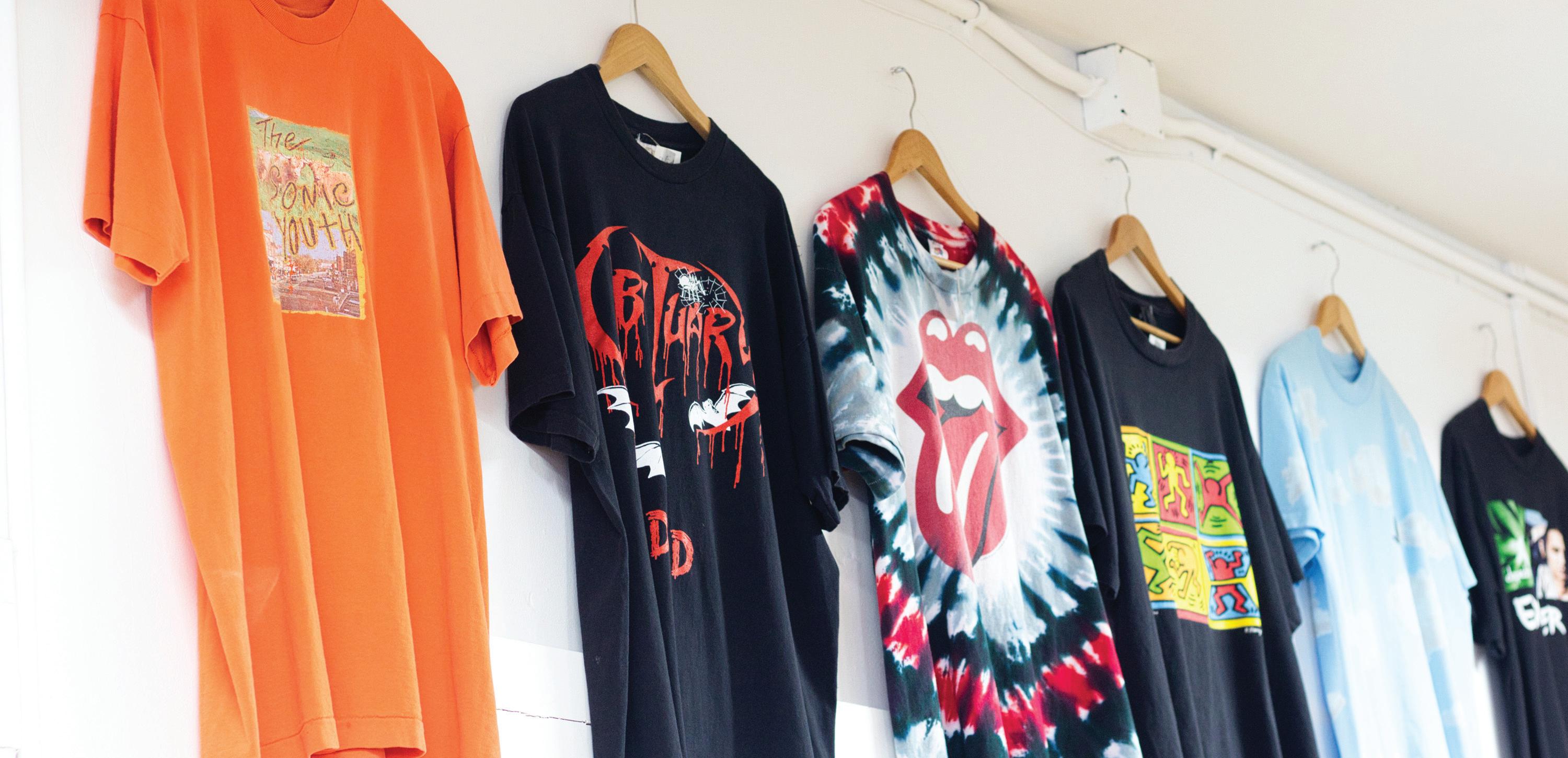
Thrifting, upcycling and donating are a few ways that consumers can lessen their ecological footprint.


Lynne Trulio, San Jose State environmental studies department chair and professor, said fast fashion is one of the biggest contributors to environmental issues.
Fast fashion is the term used to describe the method whereby the fashion industry cycles through trends at an extremely high pace, according to an Ethical Consumer webpage. As a result, purchases and disposal of clothing happen equally as fast.
“The fashion industry has really gotten a lot worse for the environment over recent decades,” Trulio said. “Those who are interested in fashion feel the pressure to constantly keep up and buy new things on a very fast basis. As a result, we are buying and throwing away clothing at a much higher rate than we ever used.”
She said it is important to highlight sustainable alternatives because fashion trends are coming and going faster than ever.
Trulio said one of the main concerns associated with fast fashion is the resulting strain on landfills.
The fashion industry produces over 92 million tons of waste each year and uses 79 trillion liters of water, according to an April 7, 2020 article by Nature Reviews Earth and Environment.
“The thing is that clothing has
an impact in all kinds of realms,” Trulio said. “There’s an amazing array of impacts, environmental but also social.”
Trulio said it is important to realize the social impacts of the fashion industry and the people it harms.
“Most clothing is produced in lower-income countries in factories by people making very little money with very little protection for their health in these workplaces,” she said.
One way consumers can avoid contributing to the strain on landfills is by donating their unwanted clothing to local thrift stores or companies such as USAgain.
USAgain is a for-profit textile recycling company that offers TreeMachine, a drop box in cities that accepts clothes, shoes and household textiles in reusable condition.
The content gets shipped to wholesalers, graders and retailers in the U.S. and around the world.
Applied anthropology master’s student Rebecca Carmick said the fashion industry is detrimental to the environment in ways that many don’t realize.
“The fashion industry and clothing is a huge contributor of waste from production to distribution to disposal,” Carmick said. “It’s an area that some people may not always recognize as a contributing factor to our waste stream.”
Carmick works as an intern for SJSU’s Office of Sustainability, an office that aims to reduce SJSU’s ecological footprint.
The Office of Sustainability partnered with SJSU Cares to establish Spartan Clothes Closet, a resource for students that seeks to alleviate clothing waste and have students meet their basic needs.
“Instead of members of the SJSU
community potentially throwing their unwanted clothing items away, they donate them to our closet which in turn could become a well-loved piece of clothing for someone else,” Carmick said.
Carmick said if consumers decide they want to give their unwanted clothes one last chance, they can also try to upcycle or repurpose them.
Software engineering senior
Eva Nicola said she started learning how to sew and make alterations to her own clothing in 2018.
She said she picked up the hobby after she learned about the harmful effects of fast fashion after watching some documentaries.
“The most sustainable fabric is the fabric that already exists,” Nicola said. “If I want something specific, I learn
how to make it and I can have whatever I want and I can save money.”
Nicola said she started by learning how to use a sewing machine and how it was quite intuitive to learn.
She said she advises beginners to stick with the hobby and think about the environmental and personal benefits to crafting one’s own clothing.
“Now I feel a lot more emotional bond to my clothes, they tell more of a story about me,” Nicola said. “If someone compliments me on something, I get to say, ‘Oh thank you, I made this,’ and it feels really great to say.”
sjsunews.com/spartan_daily WEDNESDAY, FEB. 22, 2023 ARTS & ENTERTAINMENT 4
VANESSA TRAN | SPARTAN DAILY Follow the Spartan Daily on Twitter @SpartanDaily
Black and Brown on 751 W San Carlos St. is a resale store that offers vintage apparel, modern pieces, shoes and accessories just two miles west of San Jose State.
VANESSA TRAN | SPARTAN DAILY
SJSU honors historic public art
By Christine Tran STAFF WRITER
Public Art as Resistance is an ongoing project by San Jose State’s College of Humanities and Arts that aims to highlight the history of public art in downtown San Jose.
The project was competitively selected for the California Humanities Council quick grant through the National Endowment for the Humanities.
Katherine Harris, director of public programming for the College of Humanities and Arts, and Alena Sauzade, director and collections manager at SJSU’s Natalie and James Thompson Gallery, created the walking tour.
“Our idea was to incorporate students’ ideas, languages, identities and their own community connections into the walking tour itself,” Harris said. “Every piece of artwork is a representation of the major communities, both ethnic and cultural, that surround SJSU.”
The walking tour starts at the Cesar Chavez Monument on SJSU’s campus, across from the Student Union.
Art history and visual culture master’s student Lou Jimenez is a tour guide for Public Art as Resistance and offers interactive bike tours.
Jimenez said her interactions with people who view the project is her favorite part of conducting these tours.
“When we did the tour for the San Jose Museum community and its members, I had a good conversation with an individual about cultural economy,”
Jimenez said. “I mentioned that artists are outsourced when money should be invested in local artists here. Her feedback made me focus my efforts on this more since nobody really talks about it.”
The Arch of Dignity, Equality, and Justice was created for the university by Chicana artist Judy Baca in 2008.
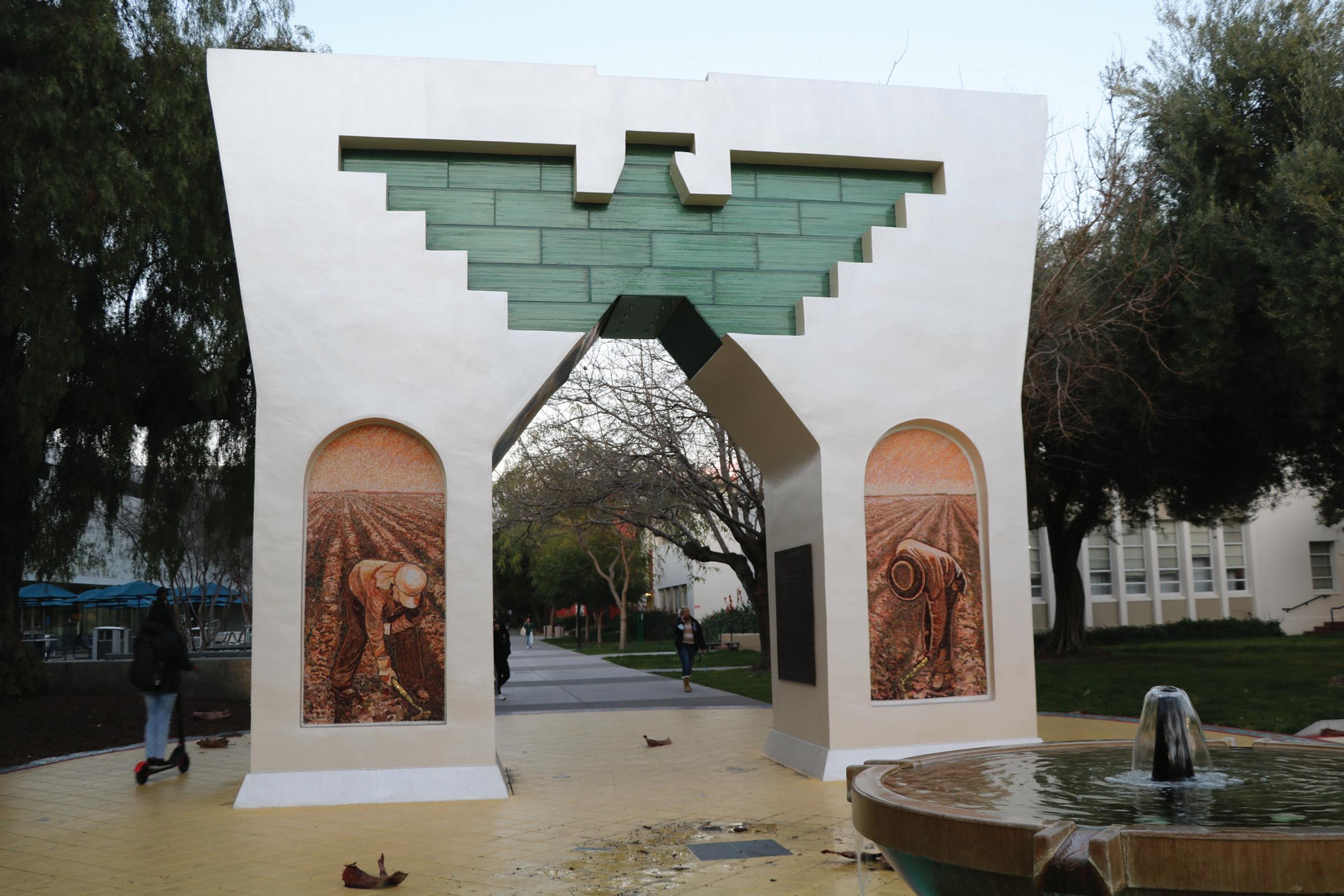
The arch is based on a Mayan corbelled arch design with Spanish and indigenous roots and features mosaic tile murals, according to a

SJSU webpage. Sauzade said Baca envisioned that SJSU students and faculty would feel empowered as we walk through the Arch and those who take a walking tour are asked to do the same.
The structure commemorates Cesar Chavez, a Mexican-American labor leader and civil rights activist, and his commitment for farm workers’ rights.
The exterior pillars display Dolores Huerta, Chavez’ co-founder of the United Farm Workers labor union, and Mahatma Gandhi, who influenced the union with his nonviolence philosophy, according to the same SJSU website.
The top of the arch is the symbol of the United Farm Workers Union: the eagle.
Below it, on opposite pillars, there are a male and female farm worker from the Salinas Valley while the interior is a portrait of Chavez, the Virgin of Guadalupe and a skull symbolizing the deaths of farm
workers because of harsh working conditions, according to the same SJSU webpage.
Sauzade said these exhibitions reflect the cultural diversity at San Jose State.
She said the Arch of Dignity, Equality, and Justice is one of the most significant pieces of art in the tour.
“Not only is it a beautiful example of a mosaic piece and a large scale public art sculpture, I just find it fascinating how it talks about the work of nonviolent protesters in a narrative form,” Sauzade said.
“It utilizes mosaics in a way that is accessible to students but it also serves as a gesture of empowerment. I think that physical experience is really special and powerful.”
Sauzade said she selected these pieces for the route with her co-organizers. She said one of the pieces they included was the Japanese-American Internment Memorial on 300 S. First Street.
She said it was created by Ruth Asawa in 1994 who spent four years in a Japanese internment camp based in Rohwer, Arkansas with her family.
The large bronze sculpture shows the “key aspects of the Japanese-American experience, before and after WWII with a central focus on the experience of the incarcerated Japanese Americans during the war,” according to a SJSU webpage. Its mural shows heavily armed soldiers representing the war, combined with the community and labor force at the internment camps, according to the same SJSU webpage.
Sauzade said it is a reminder for us to acknowledge California’s dark history and how the culture and lives of Japanese-Americans flourished before and after this time.
“In terms of history, it’s so easy for us to kind of turn the page and pretend it never happened,” Sauzade said. “And that’s something that the federal government very
BRYANNA BARTLETT | SPARTAN DAILY
much did, so placing that work in front of the federal government building is a gesture of resistance.”
Harris said the context behind art pieces like these are often overlooked, and she said she would love to see a QR code at every form of art so that we can learn more about it.
“As a resident of San Jose and a longtime faculty member at San Jose State, [public art] offers me a sense of beauty in the middle of an urban environment,” Harris said. “It also allows me to ruminate on that particular piece of artwork and who it’s about and relate to it in ways that maybe I haven’t done before.” Public Art as Resistance is scheduled to open the tours again in March.
Don’t sleep on Snoozi’s fi re bars
By Jeremy Martin SENIOR STAFF WRITER
music on multiple platforms.




Electrical engineering senior Meher Singh studies by day, but lays out vibes by night.
eeri ng senior Meher ay,
He said he tries to utilize his social media platforms to announce upcoming projects, but his reach hasn’t gone too far because of how difficult it is for artists to put themselves out there nowadays.
Singh goes by the name Snoozi and has one released song, titled “Demon” on Aug. 12, 2022.
“Demon” is a track that combines a fast-paced beat with melodic lyrics. The song is on Spotify, has 180 views on YouTube and available for purchase on iTunes.
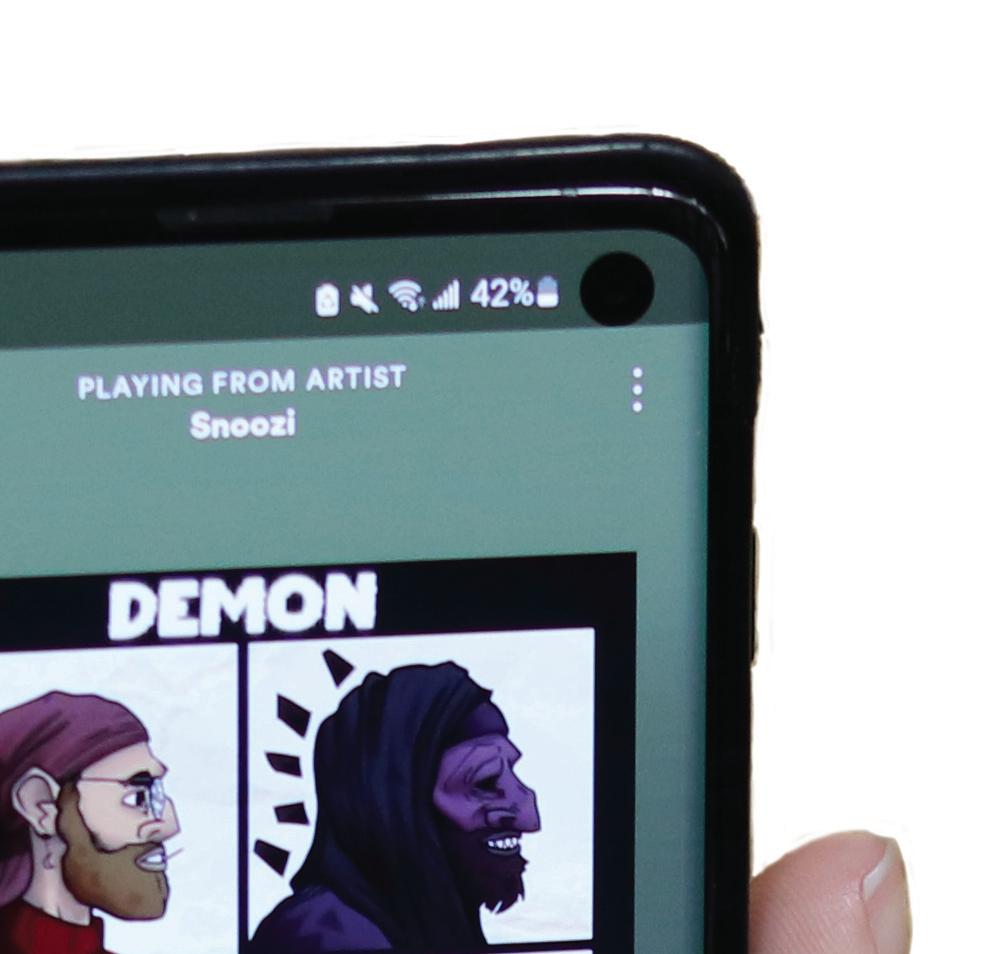
he name Snoozi and ng, t ra ck t hat combin es tify, views able rtists are s ome ns for
Singh said artists like Migos, Travis Scott and NAV are some of his biggest inspirations for his signature sound and career.
proj ects, but his reach hasn’t too far Sing h said he doesn’t think he’s reached nature of on his own. the amount

Singh said he doesn’t think he’s reached the point in his life to be signed to a label just yet because he loves the independent nature of doing things on his own.
“Right now my goal is to create the best music I’m capable of, and once my portfolio can show a decent amount of variety in what I can do, then I feel like
I wouldn’t say I have a consistent writing process, but in general it would start with a melody, cadence, flow and I fill in the gaps from there.
I would be interested in getting signed,”

Sing h said.
“I wouldn’t say I have a consistent writing process, but in general it would start with a melody, cadence, flow and I fill in the gaps from there,” Singh said.
I have a consistent t y, cadence, m there,” Sing h said.
Singh says he tries to focus on his music in his free time and that he’d like to keep school and his music career separate.
ries to focus on his and ool and his music
“Being a student and artist can be challenging,” Singh said. “Obviously I don’t get all the time to do music due to my engineering work, and it is hard to be in a creative mindset with deadlines for a project around the corner.”
nt and artist can be h said.
me to do music due to rk, and it is hard to be et a corner.” king
Singh is also working on promoting his
While being signed would change everything for him, Singh said that he would rather stay independent.
would rather independent.
He said the freedom of being independent is also an important plus on his music in terms of control
He said the freedom of bei ng inde pe ndent is also an i mp orta nt and creativity.
a to Sing h’s music.
Some SJSU students have already taken a liking to Singh’s music.

engineerin g
the new sounds that Sing h created.
Swayam Shah, an engineering management grad student, said he liked the new sounds that Singh created.
“I mostly don’t listen to rap so much, but this was a refreshing beat and the lyrics are amazing,” Shah said.
amazing ,” Shah said.
Jacob Saechao, a visitor who stopped by the SJSU campus on Tuesday
afternoon, said Si S ngh’s ar tists to.
afternoon, said Singh’s sound sounded similar to the artists he listens to.
“It was pretty good. It reminded me of those mainstream rappers, kinda like Travis Scott. So, it was pretty good,” said
of those mainstream rapp ers, kinda like Travis Scott. So, it was prett y go od,” said Saechao.
Singh said he plans to commit and continue his music career throughout the next five to 10 years.
“Hopefully I will have at least 1-2 full projects released by then, as well as more capacity to do music more regularly,” Singh said. “ As much as I would want
to commit to do music full time, I also have a career in electrical engineering that I also want to pursue, and getting to the point with music to support your lifestyle is dependent on luck, so I have to be realistic as well.”
and to the p oint your to rea list ic as












Follow the Spartan Daily on Twitter @SpartanDaily

sjsunews.com/spartan_daily WEDNESDAY, FEB. 22, 2023 ARTS & ENTERTAINMENT 5
continue his music career throug hout the proj ects R
Meher Singh electrical engineering senior rapper
CAROLYN BROWN| SPARTANDAILY
The Arch of Dignity, Equality, and Justice stands in front of the Student Union on Tuesday afternoon. It was created by Judy Baca in 2008. Follow the Spartan
Daily on Twitter @SpartanDaily
SWANA students need more representation
SJSU needs to be more aware of marginalized ethnic groups
“Easterners” with a patronizing gaze, as if we’re uncivilized, foreign creatures.
Meanwhile, Southwest Asian or West Asian is a term properly addressing the region in reference to what they actually are.
They’re not being referred to as being in relation to another location, but as to what they are; a region in Southwest/Western Asia, instead of “slightly middle east of Europe.”
as, “A term that’s used to describe white people who consider themselves wonderful helpers to Black, Indigenous and People of Color (BIPOC) — but they “help” for the wrong reasons (and sometimes end up doing more to hurt than help).”
Another great example of the school neglecting the region would be the Halal Shack on our campus.
mattered until I attended UC Riverside’s SWANACON, a convention for students identifying within the SWANA demographic, this January.
I never understood true representation and empowerment until I was in a room
communities hear about the struggles their community faces, rather than their increasing growth and success in this country.”
The article continues, expressing a deeply rooted issue of imposter’s syndrome
as a cultural sanctuary, an opportunity for social justice support and as a professional networking opportunity.
When I applied to this school I didn’t know what race I was.
It sounds absurd, but between “white,” “Asian,” and “other,” I didn’t have any options to identify with as an Afghan student.
This doesn’t just apply to Afghan students, but a majority of other South, West Asian and North African students, or SWANA students.
This means that SWANA students don’t have any accurate statistics reflecting their ethnic backgrounds, as they’re scattered and sorted between other inaccurate labels.
In other words, we’re four steps behind other minority groups, because we do not exist on paper.
There is no way to calculate how many of us are on campus, therefore students with cultural backgrounds ranging from Morocco to Bangladesh are neglected.
SWANA is a term often used interchangeably with MENASA, which stands for Middle Eastern, North African and South Asian.
So why are there two different phrases?
Southwest and West Asian is the same thing as Middle Eastern, but a less problematic variation of the term.
The term Middle Eastern stems from a Eurocentric (specifically an Anglocentric) position and promotes a heavy sense of exoticism and orientalism. It’s the “West,” “Middle East,” “Near East,” “Far East,” etc, all in juxtaposition to Europe.
Palestinian-American author Edward

Said defines orientalism as, “A political vision of reality whose structure promotes the difference between the familiar (Europe, West, ‘us’) and the strange (the Orient, the East, ‘them’).”
The concept is essentially looking at
The name “Middle East” has been excessively tarnished with time, no thanks to Western media and ideologies.
Whether it’s an entire region between two continents being condensed and stereotyped as a singular, dusty, wartorn region in the media, or completely fetishized to cater to Western audiences, the term “Middle East” does more harm than good.
By the end of the day, it’s a lazy term clumping a diverse group of people, completely erasing their identities in order to feed into the white-savior complex.
Healthline defines white-savior complex
The restaurant opened in the beginning of April 2022, according to a Facebook post. Ironically enough, the restaurant is supposed to represent cuisines from Islamic nations, but its grand opening was during Ramadan, an Islamic month when Muslims fast from sunrise to sunset for 30 days.
SWANA students are nonexistent in the eyes of the institution, and because of that, our school doesn’t recognize us or our cultures. Although San Jose State hosts Asian events every now and then, they’re mostly catered towards East Asian students, with a token South Asian reference tossed in if we’re lucky.
I didn’t realize how much representation
Unfortunately, if we want any representation as SWANA students, the burden is on us to show our school that we exist and are willing to fight for a space on campus. It’s definitely not a quick and easy process, but a consistent and long term battle is needed for consistent and long term results.
full of other people who looked just like me.
For once I wasn’t the minority amongst minorities. I didn’t realize how much I needed to see other curly haired, aquilinenosed women standing on stage, thriving in their careers. That was the first moment in 21 years of my life where I didn’t feel like an outsider.
I felt like it was realistic and actually possible for someone like me to succeed as an Afghan, and not just as an “other” label. Representation truly matters, and research has proven that it stems deeper than superficial purposes. According to a Nov. 19, 2018 Diverse Magazine article, “Research has shown that having rolemodels and mentors who share racial/ ethnic identities can contribute to an individual’s self-concept of pursuing similar careers. Too often, people from underrepresented racial or ethnic
restricting minorities and serving as additional obstacles in their careers and personal lives.
A Nov. 17, 2022 article from Very Well Mind defines imposter’s syndrome as “the internal psychological experience of feeling like a phony in some area of your life, despite any success that you have achieved in that area.”
That experience was what motivated me to initiate a movement with Jinni Pradhan, the Program Director of the Center for Asian Pacific Islander Student Empowerment (or CAPISE) on our campus. We’ve been working towards building and establishing a SWANA department, because seeing other minorities thrive in their respective departments served as further inspiration to lead our own movement.
The vision is for the department to serve
Ideally, each recognized student organization would have a representative to serve as a part of the “coalition” on behalf of their clubs.
Additionally, it would serve as a strengthening network for other recognized student organizations as well. A majority of these groups are recently established and/or do not have enough members and exposure. It’d be the only space that these students would have to feel culturally represented, and a large number of them remain at risk for essentially going extinct.

This issue doesn’t only exist on campus.
Northern California used to have Afghan Student Associations scattered all around, but the number has drastically decreased. Today, there are only four; SJSU, University of California Davis, University of California Berkeley, and California State University Sacramento.
Last semester was the first time I’ve felt seen at an event on campus. We hosted a SWANA Social/Cultural
Mixer through the Cesar Chavez Community Action Center, where I work. It’s safe to say it was a hit. Students loved it, and even asked for the event to be held annually.
Some of the attendees even expressed how homesick they were, and how they didn’t realize how much they needed to be in an environment that felt culturally familiar to them.
But what they didn’t know was that it was hosted by us SWANA students and not the school.
Unfortunately, if we want any representation as SWANA students, the burden is on us to show our school that we exist and are willing to fight for a space on campus. It’s definitely not a quick and easy process, but a consistent and long term battle is needed for consistent and long term results.
That’s why we urge SWANA students at our school to advocate for their own space on campus by filling out the SWANA Coalition Sign Up form in order to compensate for the lack of statistics and voices. SWANA students can also contact Saugher Nojan, assistant professor of sociology and Asian American Studies, for more information.
sjsunews.com/spartan_daily WEDNESDAY, FEB. 22, 2023 OPINION 7
sjsunews.com/spartan_daily WEDNESDAY, FEB. 22, 2023 OPINION 6
Follow the Spartan Daily on Twitter @SpartanDaily ILLUSTRATION BY MYENN RAHNOMA MAT BEJARANO CONTRIBUTED TO THIS ILLUSTRATION
For once I wasn’t the minority amongst minorities. I didn’t realize how much I needed to see other curly haired, aquiline-nosed women standing on stage, thriving in their careers. That was the first moment in 21 years of my life where I didn’t feel like an outsider.
Myenn Rahnoma SENIOR STAFF WRITER
SJSU continues historic skid
By Nathan Canilao EXECUTIVE EDITOR
Despite holding an early lead, the San Jose State men’s basketball team dropped their second straight game as they lost 66-51 to the University of Nevada, Reno on the road on Tuesday night.

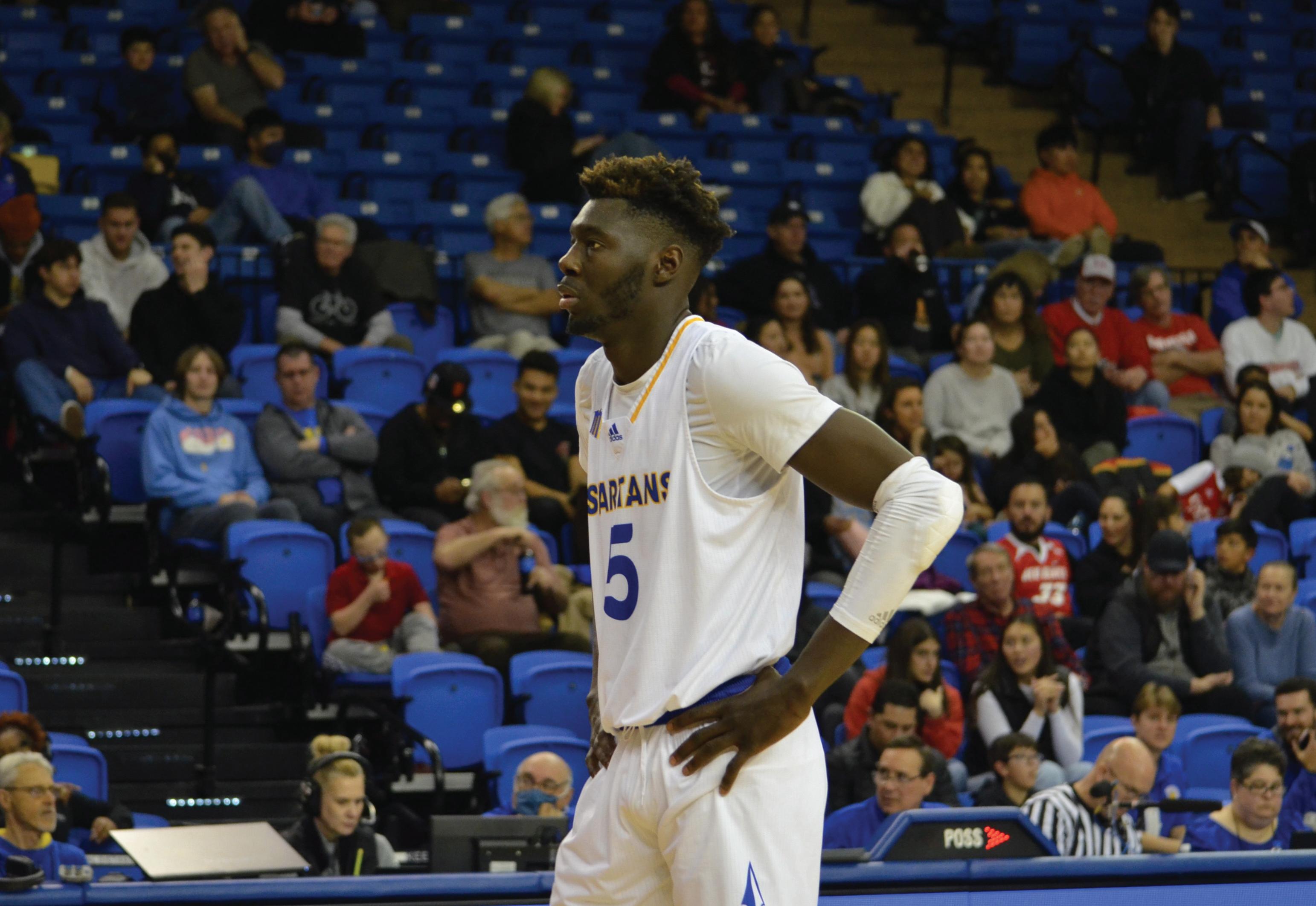
Senior shooting guard Omari Moore had 13 points, 4 rebounds and 4 assists. Sophomore point guard Alvaro Cardenas recorded 8 points and 6 assists.
Moore was the only Spartan to score in double digits.
SJSU’s last win in Reno came in 2014, and its losing streak at Lawlor Events Center extends to seven games.
“We ran out of some offense,” said SJSU head coach Tim Miles. “I thought we settled for some threes and we just couldn’t sustain [our offense.]”
The Spartans came into this game after suffering their worst conference loss of the season to New Mexico, on Saturday night at home.
SJSU’s second worst conference loss of the season came against Nevada on Jan. 7 when it lost 67-40 at home.
Nevada came into this matchup ranked No. 35 in the country according to the NCAA Net Rankings.
6:01 mark of the first half to take an early 23-16 lead.
The Wolf Pack weathered the early storm and came within four points at halftime.
Going into intermission, SJSU led 28-24. A strong 10 point performance by Moore helped the Spartans maintain a first half lead.
The Spartans started the second half strong. A 6-0 run starting at the 17:40 mark of the second half gave SJSU a 36-29 lead.
They won notable games against Boise State, Utah State and San Diego State, all of whom were ranked in the top 25 at some point this season.
The Spartans went on a 7-0 at the
Nevada responded with a big run of their own in the late stages of the second half.
After taking a seven-point lead after the break, the Wolf Pack went on a
29-12 run, shifting the momentum and closing out the Spartans on their home court.
Nevada junior center Will Baker had a huge second half, scoring 12 points. He totaled 18 points and 5 rebounds for the game.
The Spartans cold shooting in the latter part of the second half was a key reason why they lost.
After Moore led the Spartans’ offense in the second half, he would only score 3 points on 1-of-6 shooting from the floor.
Moore’s first shot in the second half came with just over 8 minutes left in the game.
“When we weren’t shooting well, if
[we’re] not making threes, where else can we score,” Miles said about the lack of offense in the second half. “If they’re gonna commit that much attention to Omari, we’re gonna need everybody . . . We did not get that tonight.”
The Spartans are scheduled to come back home to face Boise State at 4 p.m. on Saturday at the Provident Credit Union Event Center.
SJSU lost its last matchup with the Broncos 67-64 earlier in a closely contested match back in January.
sjsunews.com/spartan_daily WEDNESDAY, FEB. 22, 2023 SPORTS 8 EDITORIAL STAFF EXECUTIVE EDITOR NATHAN CANILAO MANAGING EDITOR ALESSIO CAVALCA ASSOCIATE EDITOR BOJANA CVIJIC PRODUCTION EDITOR CAROLYN BROWN NEWS EDITOR RAINIER DE FORT-MENARES A&E EDITOR VANESSA TRAN OPINION EDITOR JILLIAN DARNELL CONTACT US EDITORIAL –MAIN TELEPHONE: (408) 924-3821 EMAIL: spartandaily@gmail.com ADVERTISING –TELEPHONE: 408-924-3240 ADVERTISING STAFF ADVERTISING DIRECTOR MIA WICKS CREATIVE DIRECTOR BRIANNE BADIOLA ABOUT The Spartan Daily prides itself on being the San Jose State community’s top news source. New issues are published every Tuesday, Wednesday and Thursday throughout the academic year and online content updated daily. The Spartan Daily is written and published by San Jose State students as an expression of their First Amendment rights. Reader feedback may be submitted as letters to the editor or online comments. SOCIAL MEDIA EDITOR BRYANNA BARTLETT PHOTO EDITOR ALEXIA FREDERICKSON COPY EDITORS CHRISTOPHER NGUYEN GRAPHICS EDITORS HANNAH GREGORIC JANANI JAGANNATHAN MYENN RAHNOMA SENIOR STAFF WRITERS ADRIAN PEREDA JEREMY MARTIN OSCAR FRIAS-RIVERA STAFF WRITERS ALINA TA BRANDON NICOLAS CHRISTINE TRAN DYLAN NEWMAN DOMINIQUE HUBER ENRIQUE GUTIERREZ-SEVILLA MAT BEJARANO MATTHEW GONZALEZ PRODUCTION CHIEF MIKE CORPOS NEWS ADVISER RICHARD CRAIG EMAIL: spartandailyadvertising@gmail.com CORRECTIONS POLICY The Spartan Daily corrects all significant errors that are brought to our attention. If you suspect we have made such an error, please send an email to spartandaily@gmail.com. EDITORIAL POLICY Columns are the opinion of individual writers and not that of the Spartan Daily. Editorials reflect the majority opinion of the Editorial Board, which is made up of student editors. NATHAN CANILAO | SPARTAN DAILY ARCHIVES
SJSU junior center Ibrahima Diallo walks back to the free throw line during a game against New Mexico earlier this season. Diallo finished with 6 points against Nevada on Tuesday.
NATHAN CANILAO | SPARTAN DAILY ARCHIVES
Sage Tolbert III (left), Trey Anderson (middle) and Alvaro Cardenas (right) sit during a timeout against New Mexico earlier this season.
@nathancanilao MEN’S BASKETBALL 51 SPARTANS WOLF PACK 66
Follow
Nathan on Twitter













































